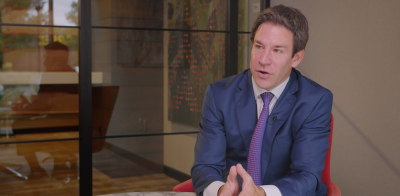Q1 Disaster for 60/40…yet the outlook is still challenging. Economy still in good shape despite recession risk creeping marginally higher. Is the Fed clueless or is there a method to their madness?
- So here we are, three months into the year with the BAGG down around 6% (almost twice the losses of all of 1994) and the S&P 500 down around 5%. Equities have certainly clawed back some of the early year’s losses, despite the Russian invasion of Ukraine and the Fed moving more aggressively. However, it was still a rather challenging quarter for 60/40 asset allocation to say the least: Down a whopping 5.4% as bond investors experienced a debilitating migraine and equity investors suffered from a mild headache (both relative to historical experience the past 30 years). The great financial asset to real economy mean reversion has begun.
- Fortunately, in a challenging environment for markets, a select group of alternative investments finished the quarter in the black: senior secured CRE debt, low beta multi-strategy, tangible asset-focused mutual funds, and Business Development Corporations, particularly those that came into the year trading at a discount to NAV with continued improvement in credit quality.
- The key(s) to each of these strategies’ success so far this year has been high levels of market and economic resilience and floating rate income (CRE Debt), floating rate strategies with improving credit quality despite high historical volatility in market downturns (BDC), the ability to monetize heightened levels of market volatility (multi-strategy), or substantial exposure to previously unloved industries like basic materials (tangible asset).
- Unfortunately for broader markets, many of the themes we have discussed in our research pieces, most notably the eventual decline of money supply growth as the Fed moved to tighten policy (“tightening cycles never go well”) left a dent in Q1. Looking forward, it is hard to draw anything but the conclusion we guided our clients to coming into the year: Tighter money = less than stellar outcomes for both equities and bonds, particularly at a time when equity multiples are still close to record highs and bond yields are still exceptionally low, given the expected pace of Fed tightening and rampant real economic inflation.
After the recent rally (remember, the most powerful rallies are always in bear markets), it is still very hard to get excited about equities given that multiples are back to around 20x 2022 and 18x 2023 expected earnings. Despite the Fed now guiding markets to seven hikes this year, no decline yet in balance sheet size (in fact, continued growth), money supply growth only meaningfully lower in February so far, shocking inflation numbers, further unwinding of globalization, and an energy and food price spike driven by the horrific Russian invasion of Ukraine, only about one multiple turn of compression has occurred so far this year. Lastly, one of the key reasons corporate profitability has soared over the years has been the reduction in labor’s share of national income, which was driven in part by globalization and outsourcing American jobs and supply chains. This trend had started to go the other way several years ago for both political and financial reasons. Now, the pandemic and Putin’s recent barbarism have accelerated the countertrend. So, it is certainly possible that equity multiple compression has run its course—but highly unlikely. - In duration-sensitive fixed income, despite yields surging in Q1, we were coming off exceptionally low levels and the 10-year is only 65 bps above where we were one year ago, yet inflation numbers are 3.9% to 6.2% higher depending on the index. Furthermore, one year ago, most market participants still believed inflation would be transitory and in the rearview mirror by now, and the Fed would be able to remove excess accommodation at a snail’s pace. Now strategists and perhaps even the Fed itself are tripping all over everybody to increase the projected pace and magnitude of Fed hikes, and it is probably clear to everyone that inflation will persist at higher rates for longer than expected one year ago. With this backdrop, it is hard to argue that the risk/reward of being long duration-sensitive fixed income is materially better than 12 months ago unless you believe a recession is imminent.
- Despite our less than ebullient view on 60/40 asset allocation, we are still constructive on the U.S. economy and also on corporate earnings (which will limit the negative impact of the previously discussed multiple compression). There is obviously a lot more concern about recession risk given a flattening yield curve, a more aggressive Fed, rampant inflation, still declining consumer confidence, an energy/food spike and geopolitical risks. Coming into the year, recession risk was as close to zero as possible. Clearly the risk has increased, but given still high levels of wage (5.6% year over year) and withholding tax growth (21% year over year), five million more job openings than unemployed, over $25 trillion more in consumer wealth driven by both home price and financial asset inflation, a pent-up corporate cap ex and inventory rebuilding cycle, unprecedented liquidity in the economy (close to $5 trillion more in commercial bank deposits) and still exceptionally loose financial conditions, a recession still appears to be a low probability the next 12 months.
- However, we are the first to remind investors that economic soft landings are very rare and the Fed is in a really tough spot…which, of course, brings us to the Fed.
- Several weeks ago, we pointed out some of the cognitive dissonance at the Fed the past six months and some policy steps that have been outright bizarre like ramping up the balance sheet by another close to $50 billion the week before hiking rates. However, it does appear there might be a method to their madness or so we hope. So, what are they up to? Why the heck would the Fed not only not shrink their balance sheet at all prior to hiking, but also actually expand it? And why would they arguably appear to be favoring interest rate hikes as opposed to balance sheet shrinkage to tackle inflation? In order to answer that, let’s look at the two channels the Fed uses to control money supply growth, which in turn principally impact either bank lending or financial conditions (a sophisticated way of saying how rich or cheap financial assets are and how high or low interest rates are) and in turn impact economic growth.
- The two channels to slow money supply growth are the Bank Channel and Balance Sheet Channel.
a. The bank channel is arguably more important to constrain real economic inflation especially given the recent acceleration of bank loan growth. By hiking more aggressively, the Fed can pay banks not to lend by paying interest on excess reserves (effectively incentivizing banks not to lend), which in turn slows loan growth, slows economic growth and finally slows inflation.
b. The Balance sheet channel is arguably more important for constraining asset inflation and tightening financial conditions (compressing equity multiples for instance), which over long periods can slow economic growth and finally slows inflation. - In an environment where the Fed is clearly more concerned with slowing real economic inflation as opposed to reigning in asset inflation, it makes sense that they might favor the bank channel over the balance sheet channel.
- Further, it looks like the Fed might have learned their lesson from Q4 of 2018 when balance sheet run-off at a more aggressive pace eventually stopped the high yield corporate and levered loan market from functioning, which is a real problem for running the U.S. economy. Thus, the Fed may only gradually reduce their balance sheet in order to avoid a capital market collapse and attempt to tackle real economic inflation by constraining loan growth. And you know what, they may be able to thread the needle here even if the steps they have taken and will take this year will have precious little impact on near-term inflation, which is clearly the biggest economic and political problem in the U.S. these days.
- Even though Q1 was messy for 60/40, don’t expect material improvement any time soon. Fortunately, the economy is still in decent shape. Finally, after masterful work during the acute stages of the pandemic but some puzzling moves lately, there is a nonzero probability that the Fed actually knows what they are doing in this brave new world of real economic inflation.
In conclusion, the market environment and the Fed Policy Path are clear: The Time for Alts is Now…and please, oh please I beg you, “Don’t Fight the Fed, High Five the Fed!”




